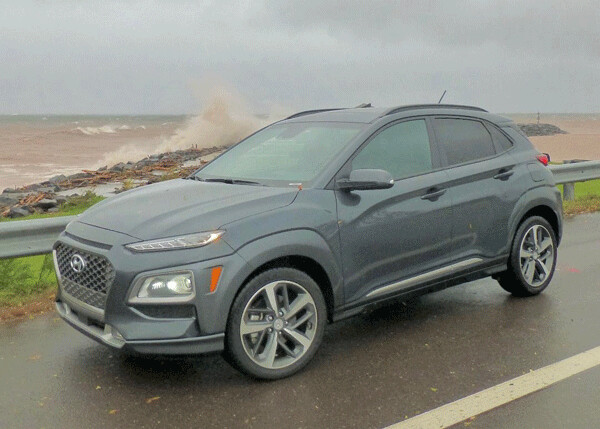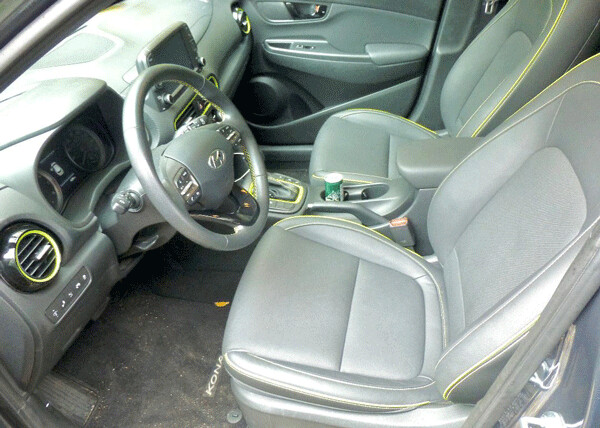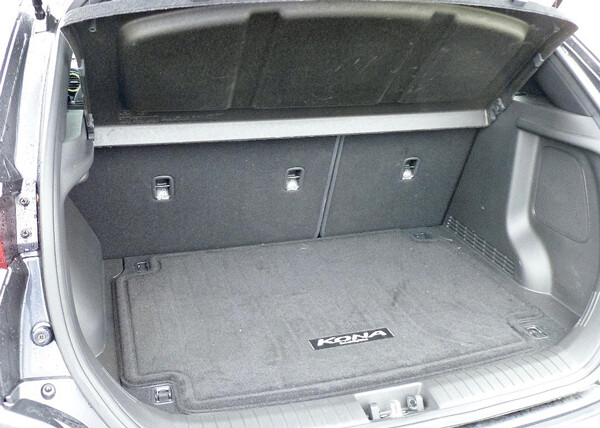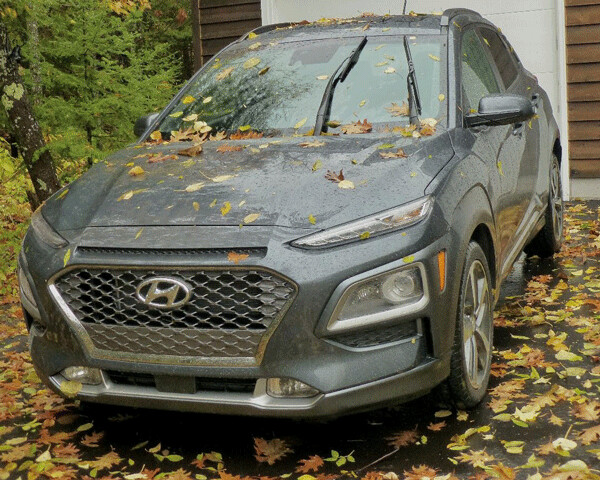News & Articles
Browse all content by date.


If you get a chance to spend a week with a new car to review, you always hope for nice weather, maybe a little sunshine and blue sky. When I belatedly got the opportunity to test the new Hyundai Kona Ultimate, the weather was almost completely the opposite.
And it provided the perfect basis for testing the subcompact SUV/
First, we got the chance to drive it home to Duluth from Chicago, and it looked like we’d have good weather until we got just across the border into Wisconsin, and all of a sudden we realized we were in some heavy winds coming at us. Along I-94, the wind was joined by monsoon-like rain in our faces. It was so bad several cars pulled off on the shoulder and on every exit ramp to wait out the heaviest part of the storm.
We just kept rolling along. First, while the Kona is the lightest and most compact of Hyundai’s fleet of SUVs, it has a lot of high-strength steel on its construction, which not only makes it feel stiff and firm to the touch, but also made it feel solid and stable no matter what the weather.
It wasn’t until we made a brief rest stop that we climbed out and realized how strong the wind actually was, because the Kona was so stable it traced its path along a trajectory that defied weather-related buffeting.
Driving west on I-94, we turned north on Hwy. 53 at Eau Claire, having stopped for a gas fill that showed we were getting 29.8 miles per gallon into that stiff head-wind. I figured we’d do even better now that we were going north, with some protection from the wind with the trees. However, the wind seemed to change with our direction, and was still blowing head-on all the way to Duluth.
The rain lessened, thankfully, and we made it just fine, listening to a late-night satellite radio broadcast of a Major League Baseball game, and assorted other things to pass the time.
Once in Duluth, we had a couple of decent days, and then we had the monster storm, with the East wind clocked at 85 miles per hour off Lake Superior by a lake freighter out in those 15-foot waves. The waves rolled over the piers at the Duluth Harbor entrance, and hammered the shoreline, including at the McQuade Road breakwater, where the crashing waves tore large square sidewalk pieces of sidewalk loose and then ajar on the breakwater as they crashed over it.
Perfect. I drove the Kona up there and got a close look, and some photos, which I was able to use as background for a few of the Kona pictures. There was a no-parking sign on the right shoulder, but a couple dozen other drivers had pulled over ahead and behind me, and there was no danger of interfering with boat-trailer-haulers thinking of launching a fishing boat into the churning tide.
Again, the Kona was a perfect companion in any weather, but seemed best sited to the foul stuff that seemed to be covering the entire Upper Midwest — our own Great Lakes hurricane, it seemed.
The Kona features breakthrough styling, and will lead the way for new redesigns of the Santa Fe — already done — and the next Tucson. It is, I suppose, “cute” by some descriptions, but it is not only comfortable to ride in for short hops or 6-hour trips, but the interior styling is both clever and attractive.
I’m not sure about the lime green outlines around the floor shift lever and along the doors, although it worked on the test vehicle, which was called thunder gray. That worked, too, and set off the black protective moldings on the wheels and fore and aft.
While the Kona handled well from its platform’s stiffness and improved suspension and steering components, I was happy to figure out that electronic switchwork could set or cancel virtually every imaginable safety, security and warning feature that could be installed on a car.


To begin with, a switch controls drive-mode selection, and it makes a difference. I found that the comfort or eco settings were both fine, but the sport setting definitely firmed up the suspension feel and the steering tightness, as well as coaxing the engine to hold its shift points longer and shift quicker. It prcludes you getting into the overdrive sixth and seventh gears of the dual-clutch automatic, but you can always switch it back into a milder setting for cruising.
Blind spot warning can also be set, and you also can program your lane-departure setting to a warning or some assistance in staying in your lane if you are careless or can just use the reminder. Rear cross-traffic warning and front collision warning with pedestrian detection is another nice feature. All of those can be programed to remain unengaged, and some drivers grumble about them being annoyances, but they are clever and intuitive features that work.
The lane departure warning also is complemented by a little chime and instrument panel icon that wonders if, after two hours of driving, you might want to consider taking a break. That’s something Audi, Mercedes and Volvo have been doing for a few years, but not budget-minded compact SUVs.
The buget-minded part is no small feature, either. We drove the Ultimate model, the top end for features from stem to stern, and it still came in loaded at $29,000. Actually, $29,805 if you include destination charges. On the sticker, it says “added features,” and the list includes carpeted floor mats. And nothing else!
Everything else is standard on the Ultimate, and you can shave the sticker price down to around $24,000 if you can stand to eliminate some of the equipment by getting a lesse model. But I like the heated front bucket seats, and the tire-pressure monitoring gizmo, which flashes a little icon to alert you to check the air pressure. Rack over the electronic switch and you can get the air pressure in the actual four tires, and on one chilly morning, when the quick drop in temperature can alter the air pressure, we had a drop in a couple of the tires. We stopped and added air, and icon blinked off.


Push-button start, and parking distance warning, and LED headlights with automatic high beams, rain-sensing wipers, heads-up display, 8-way power driver’s seat with lumbar support, and leather seating surfaces, plus a sunroof, all come together in a harmonious package.
And we haven’t even talked about how the Kona Ultimate goes. You can get a standard 2.0-liter 4-cylinder engine that works very well, but the Ultimate gets you a 1.6-liter 4 with direct injection and a turbocharger, with that 7-speed dual-clutch transmission, and it goes swiftly and holds highway cruising speed very well. It delivers 175 horsepower at 5,500 RPMs, and 195 foot-pounds of torque, peaking at a range of 1,500 to 4,500 RPMs.
In fact, the only thing missing is paddle shifters, which would have been handy, to say nothing of fun. I shifted the floor lever over into the manual gate and downshifted or upshifted manually, and that worked fine. But if it’s a sporty model, give us the sporty touch of paddle shifters.
An 8-inch navigation screen, and all the connectivity stuff you could want. The audio is 315-watt, 8-speaker Infinity by Harmon Kardon.
Incidentally, those LED headlights are complemented by foglights, although they are non-LED, and there is quite a significant difference in the brightness. I will say that the extremely sharp cutoff of the headlights on low beam is excellent, and on high beams the lights are as brilliant as any vehicle I can recall. For final touches, there are heated outside mirrors with redundant turn signal indicators, and a split fold down rear seat that expands the already surprisingly large storage area. Also, one more thing, a wireless charging pad if your smart-phone is indeed smart enough.
Hyundai has crammed virtually every imaginable feature into the Kona, and it still covers the fun, high-revving engine for 10 years or 100,000 miles, and offers a 5-year, unlimited-mileage roadside assistance package.
Coming next from the South Korean company is a Kona EV, with an over-200-mile range for the all-electric model. Judging by the excellence of the LG Chem battery pack in the compact Ionic Hyundai sedan, the low, under-the-back-seat system is compact, high-powered and leaves you a lot of storage room. But that comes in front-wheel-drive only, so we’ll be very happy getting 32 mpg in town with the weather-beating Kona Ultimate.
| Tweet |


